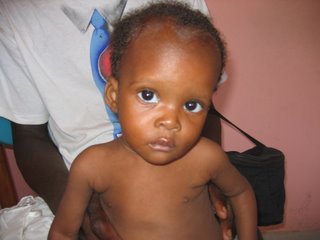
Ceftriaxone and the Purpose of Life:
“It’s not good when you see nine and ten-month-old babies with dirt under their fingernails,” says John of some of his patients. It means they are spending too much time on the ground in the filth. This isn’t a safe place for anyone, much less babies.
Some of these babies also have high fevers, brought on by various infections. Bacterial infections are treated with antibiotics. We brought 30 grams of ceftriaxone with us, a heavy duty, injectible antibiotic. This drug went generic last summer. Under the brand name, Rocephin, it cost $40 a gram. Now, it’s only $10 a gram in the United States and $33 U.S. a gram in Haiti, which is still much too expensive for the average poor Haitian.
John can usually get about two doses from each gram, depending on the size of the child. Many times he will have a nurse give one injection and have the mom and baby return the next day for another. Often after the first dose, the child will be much improved the next day. Three weeks into this trip, John has already administered about 30 injections.
Of course, the source of many of these infections is dirty water and other unsanitary conditions. Given that we aren’t eliminating the source of the infection, does our work seem pointless? No, and I’m going to let Dr. Francis Collins, who directed the Human Genome Project, one of the most scientifically significant projects ever, tell you why:
“I went to West Africa to work in a small mission hospital for a month. I went there in the midst of all sorts of other scientific endeavors. It was a bad time to leave, but I really wanted to do this. I went there with this image that I was going to make a profound difference in that situation. After a couple of weeks, I was really depressed. Here was a circumstance where all the patients I was trying to take care of had diseases that didn't have to be. They were the consequence of poor public health, of contaminated water, of inadequate nutrition. I knew I could pull some of these people back from death, but I knew they'd go right back out to that situation. My dreams of myself as the healer for this large population were lying in pieces on the floor.
“One morning I walked in to see a young farmer who we had treated the day before for tuberculosis, and he looked at me and he said, 'You know, I get the feeling that you're wondering why you're here.' He said, 'You came here for one reason. You came here for me, and that ought to be enough.' And that sticks in my mind -- more than any moment I think I have experienced in my life -- as truth. We should have our grand dreams, we should pursue them, that's what being human is all about, that's part of the nobility of our enterprise. But we should never forget that what really matters is what you do one-on-one with a single human being. Where you reach out and you try to help them make their life a little better. And if that's all you do, your whole life is to do that occasionally, then you have succeeded.”
John treated the child pictured above at the pediatric clinic at Grace Children's Hospital in Port-au-Prince.


